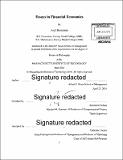| dc.contributor.advisor | Antoinette Schoar. | en_US |
| dc.contributor.author | Bernstein, Asaf | en_US |
| dc.contributor.other | Sloan School of Management. | en_US |
| dc.date.accessioned | 2016-10-25T19:53:13Z | |
| dc.date.available | 2016-10-25T19:53:13Z | |
| dc.date.copyright | 2016 | en_US |
| dc.date.issued | 2016 | en_US |
| dc.identifier.uri | http://hdl.handle.net/1721.1/105085 | |
| dc.description | Thesis: Ph. D., Massachusetts Institute of Technology, Sloan School of Management, 2016. | en_US |
| dc.description | Cataloged from PDF version of thesis. | en_US |
| dc.description | Includes bibliographical references. | en_US |
| dc.description.abstract | This thesis consists of three empirical essays in financial economics that explore the role financial regulation can play in firm, household, and investor decision making. In the first chapter for households with homes worth less than the mortgage I test the effect of "household debt overhang" on their labor supply decisions. I utilize a new transaction-level dataset with comprehensive information on assets, liabilities, and deposits for all customers of a major U.S. financial institution from 2010-2014. I then exploit plausibly exogenous variation in the timing of home purchases among households in the same region and time as an instrument for the probability of negative home equity and find that negative equity causes a 2%-6% reduction in household labor supply. These results are robust to the inclusion of time-varying national cohort fixed effects as well as using a life-event driven proxy for the timing of home purchase based on the date of college attendance. Income-contingent loss mitigation creates implicit marginal tax rates that provide a plausible channel by which household debt overhang acts. Consistent with this explanation I find that the labor supply decline is larger in regions where mortgage modifications are more prevalent, even if foreclosures occur less frequently. Taken together these results provide evidence that the moral hazard problem caused by mortgage debt overhang can exacerbate employment declines and highlights the potential unintended consequences of mortgage assistance programs. In the second chapter I investigate whether restrictions on bank speculation can be costly for non-financial firms by examining the unexpected inception of federal rating-contingent investment restrictions in 1936 preventing banks from purchasing speculative grade securities. Immediately following the ruling I find a persistent 3-5% equity value decline for firms requiring speculative financing, concentrated in industries reliant on external financing, but no change in bond yields. Rather than face increases in default risk or direct interest costs these firms reduce debt issuances to improve ratings, leading to reduced investment and asset growth in the years following the ruling. In the third chapter (co-authored with Eric Hughson and Marc Weidenmier) we explore the role clearinghouses play in global financial stability. Empirical identification of the effect of centralized clearing on counterparty risk is challenging because of the co-incidence of macro-economic turbulence and the introduction of clearinghouses. We overcome these concerns by examining a novel historical experiment, the establishment of a clearinghouse on the New York Stock Exchange (NYSE) in 1892. During this period the largest NYSE stocks were also listed on the Consolidated Stock Exchange (CSE), which already had a clearinghouse. Using identical securities on the CSE as a control, we find that the introduction of clearing reduced annualized volatility of NYSE returns by 90-173bps and increased asset values. Prior to clearing, shocks to overnight lending rates reduced the value of stocks on the NYSE, relative to identical stocks on the CSE, but this was no longer true after the establishment of clearing. We also show that at least V2 of the average reduction in counterparty risk on the NYSE is driven by a reduction in contagion risk - the risk of a cascade of broker defaults. Our results indicate that clearing can cause a significant improvement in market stability and value through a reduction in network contagion and counterparty risk. | en_US |
| dc.description.statementofresponsibility | by Asaf Bernstein. | en_US |
| dc.description.tableofcontents | Chapter 1. Household Debt Overhang and Labor Supply -- Chapter 2. More Than Just Speculation: The Costs of Restrictions on Speculative Investing -- Chapter 3. Counterparty Risk and the Establishment of the New York Stock Exchange Clearinghouse. | en_US |
| dc.format.extent | 165 pages | en_US |
| dc.language.iso | eng | en_US |
| dc.publisher | Massachusetts Institute of Technology | en_US |
| dc.rights | M.I.T. theses are protected by copyright. They may be viewed from this source for any purpose, but reproduction or distribution in any format is prohibited without written permission. See provided URL for inquiries about permission. | en_US |
| dc.rights.uri | http://dspace.mit.edu/handle/1721.1/7582 | en_US |
| dc.subject | Sloan School of Management. | en_US |
| dc.title | Essays in financial economics | en_US |
| dc.type | Thesis | en_US |
| dc.description.degree | Ph. D. | en_US |
| dc.contributor.department | Sloan School of Management | |
| dc.identifier.oclc | 960806412 | en_US |
